Drawn + Formed: Embroidery Artist Kate Barlow on keeping the wirework craft alive
The survival of traditional crafts is an issue close to the heart of Kate Barlow, a embroider and Royal School of Needlework tutor who is proficient in the ancient, but increasingly rare technique of goldwork embroidery; the art of embroidering using gold, silver or metallic wire.
The Centre’s latest exhibition, Drawn + Formed, seeks to explore the extraordinary possibilities of Kate’s chosen material, showcasing jewellery, silversmithing and embroidery that features hand-drawn wire, and juxtaposing historical works with that of contemporary makers such as Kate herself.
So for us, now, novices, what exactly is goldwork embroidery, and where would we traditionally see it applied?
Goldwork embroidery has been around for a very, very long time. It involves as the name suggests, gold or silver wire. Traditionally, there would have been some precious metal content in the wires used for embroidery, but that’s less true of the technique today - you still can get precious metal wire, but it’s a lot more expensive. Historically, however, real gold and real silver would have been used, which is why a lot of the historical needlework has tarnished over time, particularly silver wire work which can become black with age.
So goldwork embroidery basically involves stitching down wires that have been drawn to a very, very fine gauge. Sometimes they're straight, sometimes they're deliberately twisted or coiled, like in pearl purl or smooth purl wire. Some you stitch over the top, some you can cut into small lengths and stitch through. You can also get other types of wire that are much finer, such as passing thread. This is very flat wire that's been wrapped around a core thread, which you can then couch down by taking little stitches over the top of the wires in order to attach it to the fabric. Goldwork is a very sparkly technique, which I love, and you can also use it to create a lot of dimension - it doesn't always have to be flat like surface embroidery, you can put different types of padding underneath it, to raise it up and produce different effects that way.
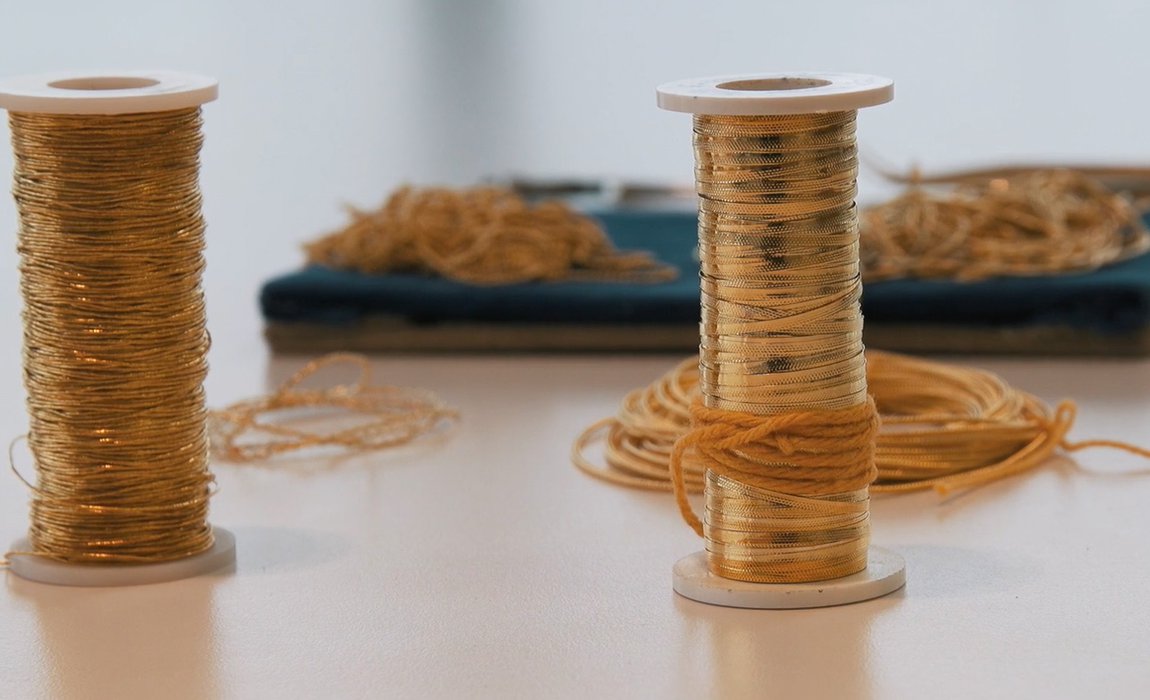
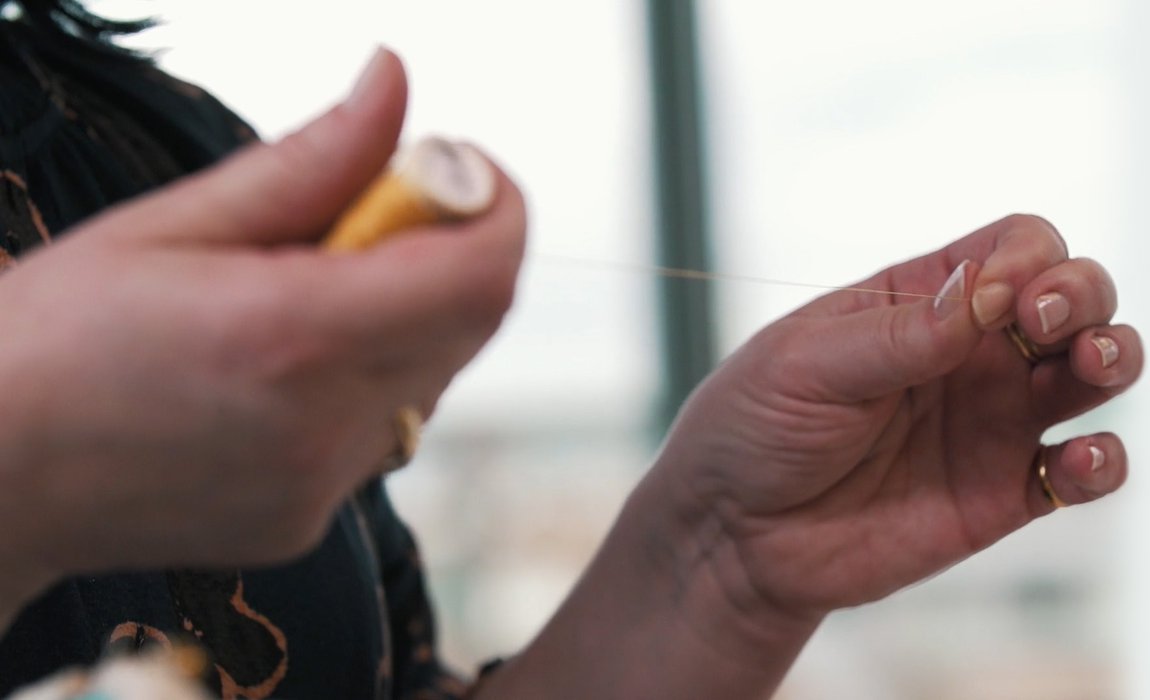
Traditionally, goldwork embroidery would have been used on military uniforms and ecclesiastical vestments. A technique called underside couching, which involves couching in a particular way and in a particular pattern was used in Opus Anglicanum embroidery. It was an expensive embroidery technique however, which is why it was limited to the upper classes, military uniforms and to the clergy. These days, it’s easier to get hold of the materials, but they’re not always precious metals, as I said. So it’s still not the cheapest embroidery technique, but it's a lot more accessible than it than it used to be.
Is wire challenging to work with?
It is initially. At first, I was a little intimidated by working with wire because it's so different.
I did my training at the Royal School of Needlework, where we learned a lot of different hand embroidery techniques, including goldwork embroidery. I was given a starter pack of different types of wire and threads, and I'd never done anything like it before, so it was daunting - you can’t use wire in the same way as cotton or silk thread. For most people, myself included, once you get over that initial fear, it’s very addictive, as it’s just so different from any other kind of embroidery. These days, you can get the wire in different colours, so although the technique is called goldwork and it would traditionally involve gold or silver wire, in modern times, metallic wires in a variety of colours are available, which opens up a lot of interesting creative possibilities.
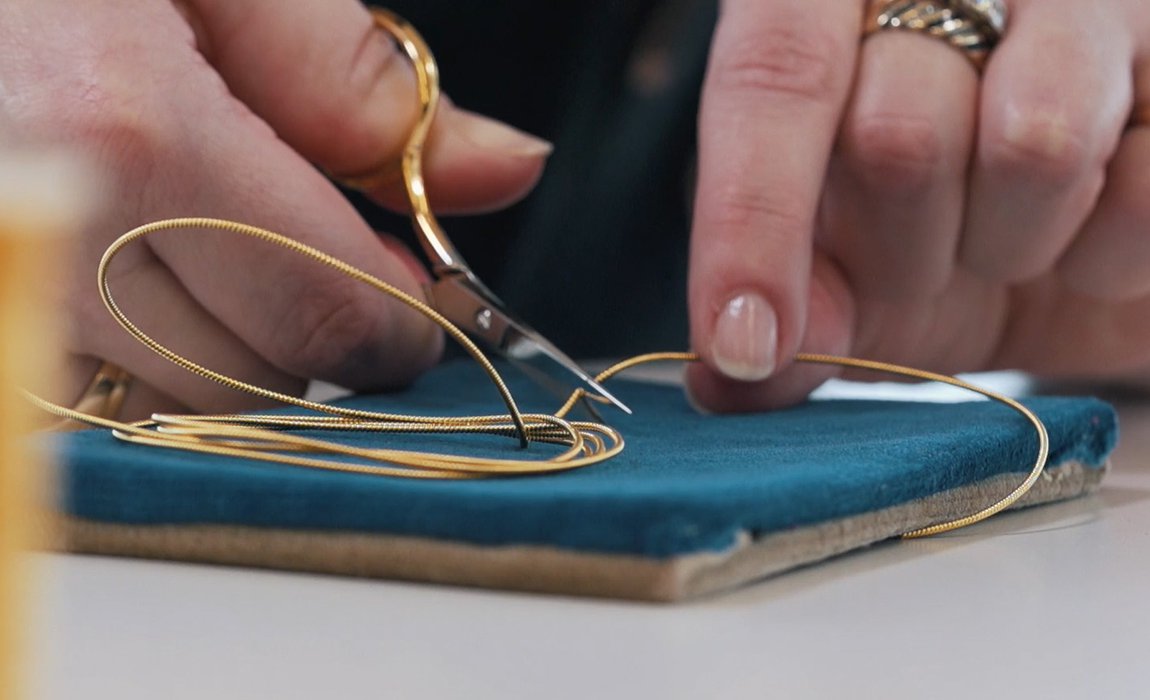
It’s very different. For example, a smooth purl wire or a wire check is a very fine wire that’s been twisted so that it’s hollow, like a tiny spring. You can cut it into small pieces called chips, which you can thread onto a needle then stitch down. Another technique using the same type of wire is called cut work, where you cut longer pieces of wire but stitch them down over padding.
Since some wires are quite rigid, you can create designs that are structural if you want to, using quite high padding. So it’s very different in that respect, and another thing you have to consider is that it is easily damaged - the wire is soft, so you must take care not to crush it once it is stitched down. That’s a big difference between this technique and other kinds of surface stitching.
How did you first become interested in goldwork embroidery, and how did you learn it as a skill?
I used to be a costume maker, and my initial degree was in Theatre Design. So I've always loved making things, and I've always been interested in textiles, particularly historic textiles and embroidery. Like a lot of people, when I was a child my grandmother taught me basic needlework skills, probably to keep me quiet whilst she was looking after me! It never occurred that I could make a career out of it, however, until I heard about a course at the Royal School of Needlework, which is their Future Tutor Programme. It’s a three-year, full-time programme that teaches different hand embroidery techniques at a very high standard, so that students can then go on and teach those same techniques at the School.
At that point, I’d done a lot of sort of surface stitching, but I'd never done goldwork embroidery before. One of the first things that I did was a module called basic goldwork; it covered design, how to use the different wires and threads, and using padding to achieve different levels and effects. As I said, I was quite intimidated by it initially, but I’ve always loved sparkly things - anything involving sequins or crystals, so learning goldwork was fabulous, because depending on the wire you choose, you can get very sparkly results. It’s not something I’d have necessarily have thought that I would like, but I realised very quickly that I found it addictive - it’s very interesting because it’s so different.
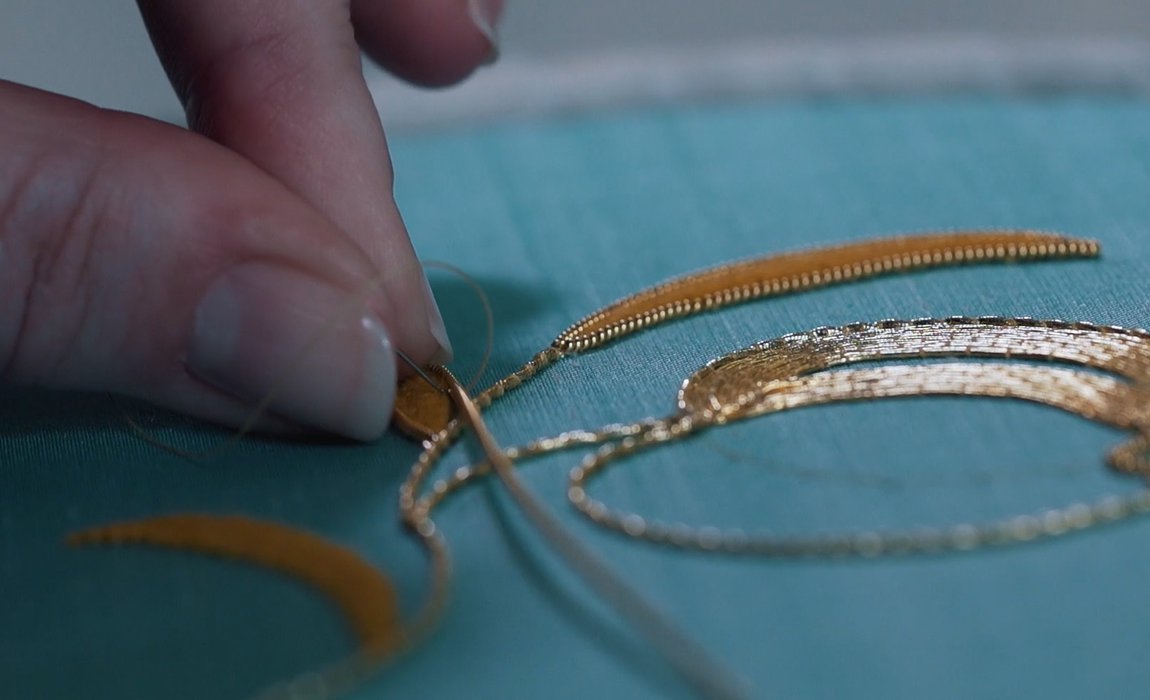
Is it quite rare to be proficient in this technique?
It’s more common in the world that I work in now, as all the tutors that work for the Royal School of Needlework must complete the basic goldwork module, an advanced goldwork module, and a module called coronation goldwork. The school has traditionally been asked to embroider coronation robes - the last one was for the Queen when she was crowned in 1953. That gown involved goldwork embroidery on silk velvet, a very particular style that’s very highly padded. So the coronation module ensures that all the tutors at the School are proficient in this technique. All of these skills are taught to a very, very high standard.
I think it’s becoming more common for people to want to try goldwork, particularly with the rise of teaching over Zoom during the pandemic. We are now able to teach people who wouldn’t necessarily be able to get to Hampton Court for classes, and it's made the subject a lot more accessible.
Would you like to see more goldwork embroidery in contemporary fashion?
My training at the Royal School of Needlework was centred around using traditional techniques and materials, however the School also offers a degree in Hand Embroidery for Fashion and Interiors, and at the end of year degree shows for this course, you often see students using goldwork in more non traditional ways, breaking the rules a bit and creating amazing pieces.
It would be amazing to see more goldwork in modern clothing. If you look back at historical fashion there was often a great deal of hand embroidery on both men and women’s clothing. Sometimes the men were more highly decorated than the ladies were, with beautiful waistcoats embellished with goldwork and silk embroidery. Remember that during this era there were no electric lights, so the embroidery would be twinkling and sparkling by candlelight, which must have just been beautiful. This kind of clothing was very expensive, of course.
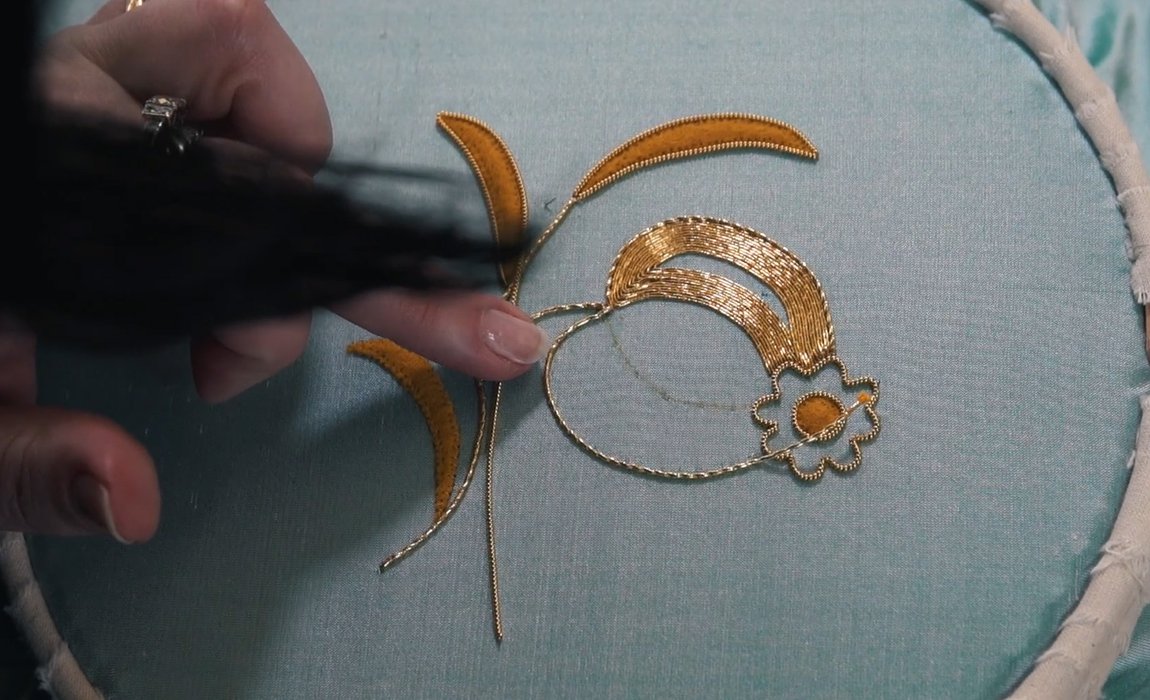
How would you describe your particular design style?
I'm very drawn to historical needlework techniques. I like to create pieces that are based on specific historic objects, and I have many students who have the same area of interest - there’s something lovely about recreating a piece that was stitched over three hundred years ago, trying to match the materials and colours as closely to the original as possible. One of the things that I love about what I do and the way that we teach at the Royal School of Needlework is that the tools, the materials and the equipment that we use haven’t changed that much. Yes, we may have higher quality needles or scissors, but actually an embroiderer from three hundred years ago could come into my classroom and pick up a needle and start stitching, and I love that we've got that link with the past. The RSN is celebrating it’s 150th anniversary this year, and I’m proud to be part of the long line of expert stitchers to school has produced during this time.
Having said that, I also like designing pieces that are a little more contemporary. I’m often inspired by the aesthetic of the 1940s and 1950s and like to create things with an air of nostalgia for that era. I like my work to make people smile.
Why do you think it's important to keep ancient crafts like this alive?
I think it's more important than ever.
As much as I love social media and feel that there are many benefits to the digital age, like being able to teach someone on the other side of the world who would otherwise never be able to take that class, everything is so fast now, everything changes by the second. Preserving historic techniques and heritage craft forces you to slow down and to focus on something that has roots dating back hundreds of years. It gives you a connection to the past, and I think that’s such an important thing. Very often, these techniques or crafts are very specific to a culture, to one part of the UK or to a specific country. If we lose the things that distinguish different cultures and make them unique, then we lose our identity. Everything will be machine-made. These are skills that have not necessarily been written down, they’ve been directly passed down between generations. It’s incredibly important to preserve that link with your roots, with your history.
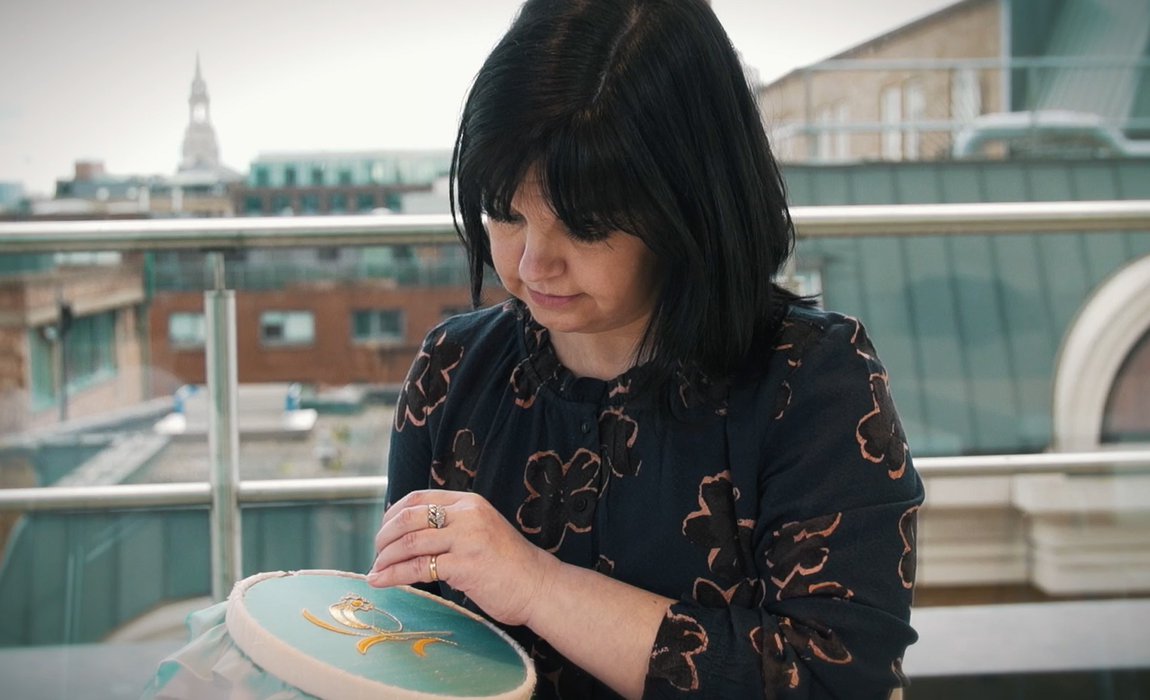
Doing things with your hands is also really good for your mental health and general wellbeing, and I think a lot of people first realised that during the lockdowns. If you look at the history of human beings, right from the beginning to the earliest cave paintings, for whatever reason, as a species, we instinctively express ourselves by making things, and by being creative. Whether it’s baking or stitching or painting, there’s something about creativity that is in-built in us. Although you can still be very creative digitally, I think it’s important that we don’t lose hand-skills. Arts-related subjects are always the first to be cut in schools due to budget restraints, and I think the people making those decisions don’t always appreciate how important these skills are, how applicable they are to so many different areas of life. It isn’t just about painting a pretty picture. My sister is a teaching assistant, and she told me that some children don’t know how to hold a pen or a pencil properly, because they’re only used to tapping and swiping. They haven’t developed those kinds of fine motor skills.
So I think preserving the heritage skills is hugely important, as is letting people know that they are viable career options. You may not be the richest person in the world being a hand embroiderer, but you'll be happy.
What excites you most about participating in Drawn + Formed?
I was in London a few weeks ago and saw Drawn + Formed, and it was great to be part of an exhibition with such varied pieces in it, and to have the chance for people to see my work. Although the pieces all involve different types of metal wire, there were so many different approaches, it just proves how versatile wire is. It’s wonderful that embroidery is now being included among jewellery and silversmithing pieces, and that it’s being recognised that the wires we use within hand embroidery are very similar.
On the The Radcliffe Red List of Endangered Crafts, the art of metal wire drawing, particularly for embroidery, is considered in danger of becoming extinct because there are so few people doing it. So anything that raises the profile of goldwork embroidery is so important.